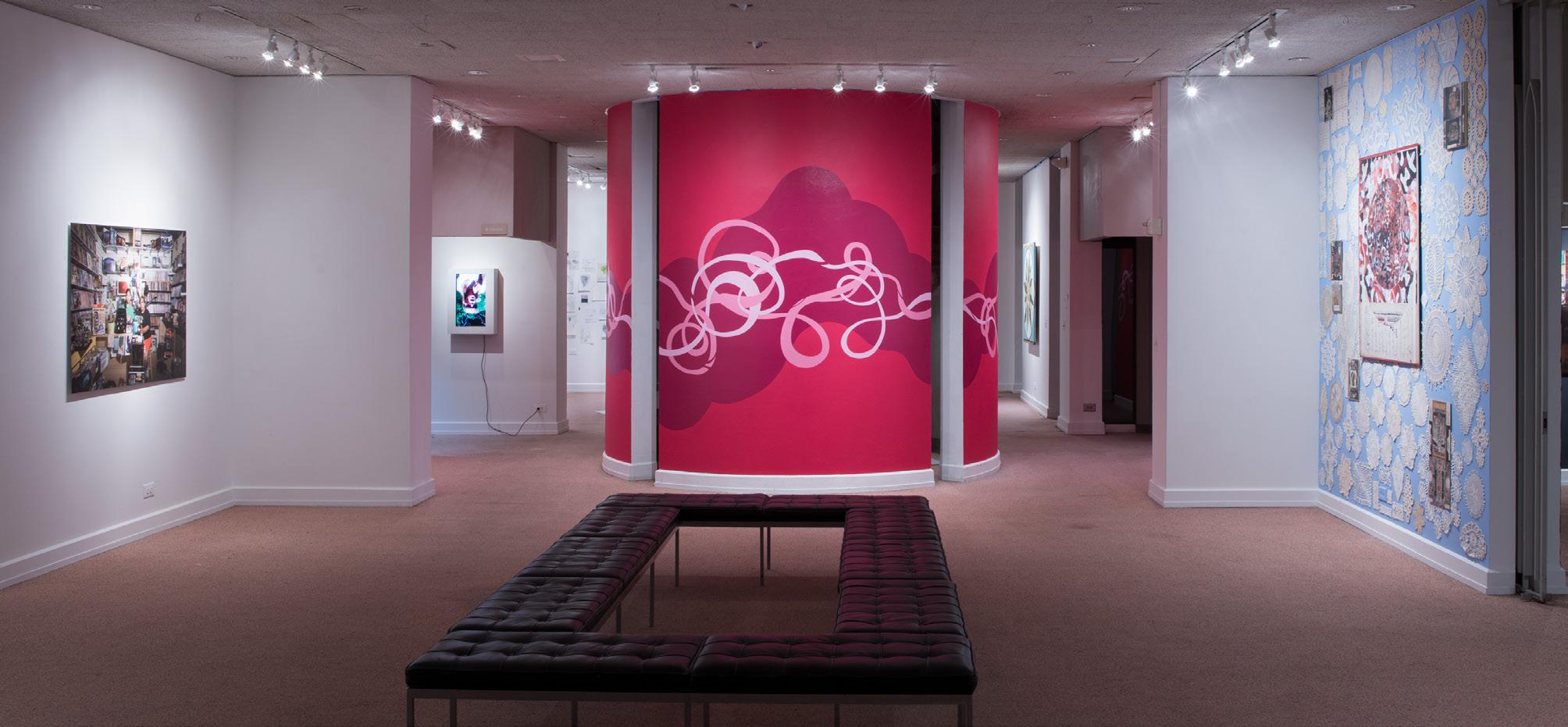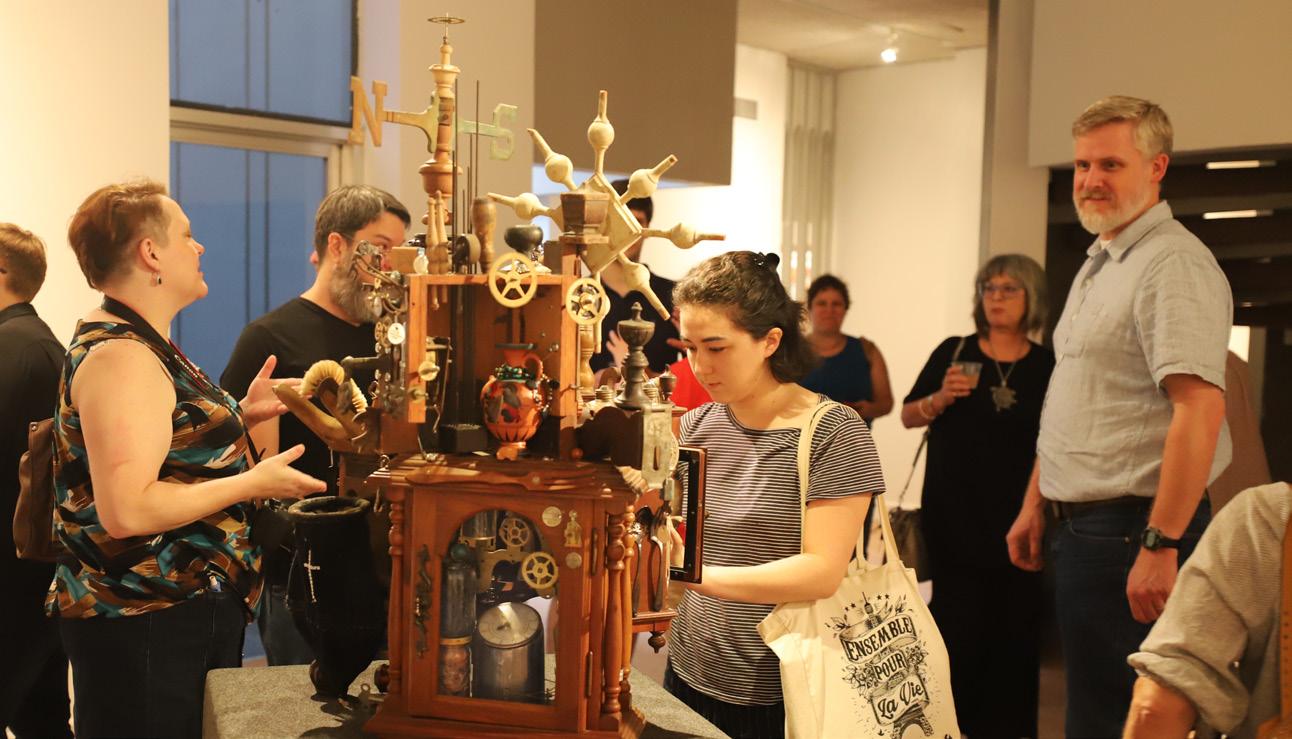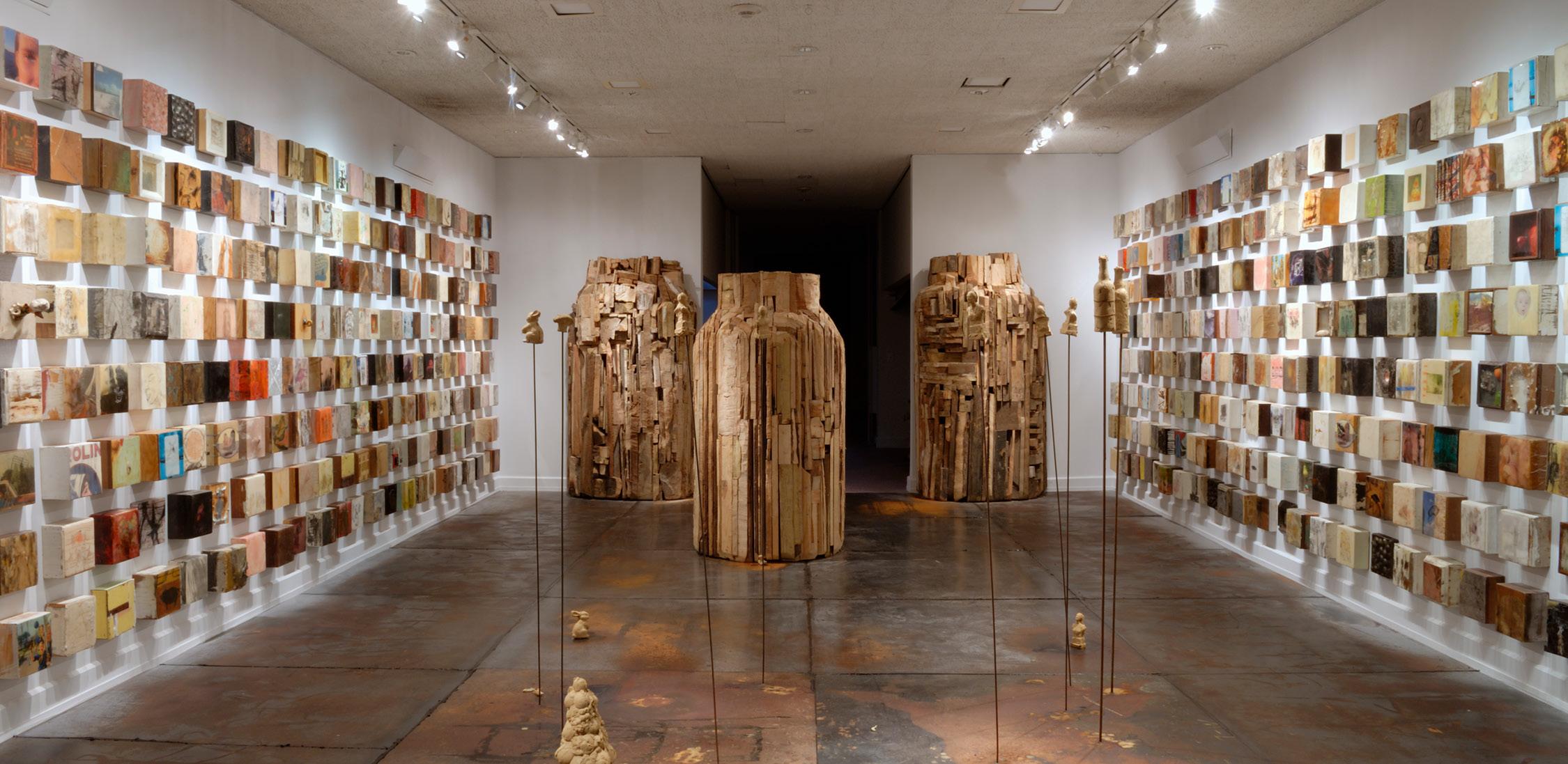
8 minute read
The Power of Art
By Karina Antenucci
Works of art live everywhere on the campus of Agnes Scott College, providing an evocative, inspiring and contemplative backdrop for the community. As people move through their day, these pieces of art from the college’s permanent collection are their silent companions, saying powerful things visually that spoken words can only hope to capture. While many are appreciative of it, some may not be aware of how this art was selected or why it is present on campus. Like every brushstroke made on a canvas by a painter, the acquisition and placement of thought-provoking works of art in the permanent collection are intentional. Art brings beauty and meaning, and at an institution of higher learning, it serves an additional purpose. For Agnes Scott, it is an integral part of the art students’ curriculum and important in the education of every young scholar at the college.
“These pieces aren’t just there to decorate the space. They provide a platform for students to ask questions of themselves and their place in the world. There is intellectual rigor involved. Every student is enriched by the art on our campus walls,” says Professor of Art Anne Beidler, who serves on the Art Advisory Committee, which is responsible for managing the permanent collection of art owned by the college.
Just a fraction of the 5,000 pieces in the overall collection are on display. They showcase high-quality examples of various styles of work: painting, printmaking, sculpture, photography and more. The roots of the collection began in the college’s early years and grew in 1965 with donations from Harry L. Dalton in honor of his wife, Mary Keesler Dalton ’25. Since then, Agnes Scott’s collection has expanded over the years. In particular, the 1990s brought a shift to both the art world and to the college’s collection, causing Agnes Scott to narrow the acquisition focus to emphasize works on paper by contemporary women artists.
“There was a lot happening in art for third-wave feminists during the ’90s. It was a pivotal point not just in the sociopolitical outlook in the art world but also within our college community of forwardthinking women. Under the leadership of thenPresident Mary Brown Bullock, our department moved toward identifying the college as an international site for women,” notes Beidler. “Art is a symbol of change, and our past and current acquisitions mirror this.”
Over the years, the Art Advisory Committee, composed of art faculty, gallery staff, alumnae and local gallerists, has made decisions to acquire and install work that best enhances the campus environment. Considerations for purchase require thoughtful review. Acquisitions must respond to a larger vision. Does the work challenge the way we think about current social and intellectual challenges? Does it speak to the process of creativity rather than the product? Does it engage liberal arts learning by touching multiple ways of knowing? What is the work’s historical, political, sociological, philosophical and religious value? Does the work have an aesthetic longevity? How does it complement and augment the current works in the collection? And finally, is it possible for Agnes Scott to responsibly steward the work over time and maintain, house, install and keep it safe from fluctuating light and temperature?

The Dalton Gallery space undergoes a creative transformation with each exhibit. The “This Beautiful Tangle” exhibit in fall 2016 was a poetic investigation of the American South, contemporary life in it and the beautiful tangle that emerges when one begins to make connections and how over time these connections shape and guide us.

The fall 2019 exhibit programming included the Voices in Arts Leadership panel featuring, from left to right, Anna Carnes ’19, assistant curator fellow; Anne Beidler, professor of art; Veronica Kessenich, executive director of Atlanta Contemporary; and Jiha Moon, artist.

In the fall 2019 Gallery Talks, as Professor of Art and Chair Nell Ruby looked on (foreground), Adena Adams ’21 presented on “Kara,” 2013, a portrait of the artist Kara Walker taken by photographer Catherine Opie as part of her “Portrait and Landscapes” series.
“Campus spaces are public spaces, so things have to be appropriately placed and protected. It’s not like a museum, where people leave their coffee and backpacks at the door,” explains Beidler.
Agnes Scott students also have an opportunity to acquire art for the college’s permanent collection. As part of the art department’s Seniors Select program, senior studio art and art history majors are given access to a budget to select a work that is then purchased and installed as a gift to honor their class. The students collaborate to generate a list of work to present and create a cohesive and persuasive argument about why the work is important for the collection. The argument necessitates a visual analysis of the work, including a detailed description of its aesthetic dynamics and historical contextualization as well as a review of its value as a teaching tool.
“In this process, students showcase their ability to contextualize and analyze the work, the art experience and how the art plays into the world at large,” says Nell Ruby, professor of art and chair of the department.
An elegant complement to the permanent collection is The Dalton Gallery, which opened its doors within the Charles A. Dana Fine Arts Building in 1965 and is named in honor of the Daltons. Everyone who enters the Dana Fine Arts Building finds themselves inside the gallery, which forms the central core of the building. As an integral part of the open-plan building, designed by renowned Atlanta architect John Portman, the gallery is a dynamic space that features four art exhibitions each year. A typical fall show features living artists and focuses topically on current social and political challenges, such as climate change, immigration or gender. The thematic emphasis of the exhibition guides the tenor of student Gallery Talks, a capstone project in which art majors research the featured artists and then present a public talk at the exhibition’s opening.

Fall 2018’s exhibit “Transformers: Artistic Alchemy” featured artists reimagining recognizable objects, subverting and enhancing them. Susan Lenz’s “Time” is a collection of found objects steeped in the symbolism of passing time.

Examining the nature of acquiring a collection and learning about art, the fall 2019 exhibit “Side by Side: Selections from the permanent collection” juxtaposed past and present works, highlighting Agnes Scott’s rarely exhibited works and recently acquired acquisitions.

The fall 2006 “Blackbird on My Shoulder: Stories and Other Truths from the South” exhibit featured visual artists, writers and performers strongly attached to the Southeast and inspired by auto(biography) and storytelling. George Long’s installation “Tincture,” year unknown, was one of the striking works included.

Fall 2020’s exhibit “Searching for Home,” supported by The Margaret Virginia Philip Art Endowment Fund, included Macey Ley’s installation and video “Family Dinner 2020: The Pandemic Year(s)?”
Photo by Karin P. Koser and Andrew Dunbar, KPKinteractive.
As Katherine Smith, professor of art history, notes, “This is the moment when our students become our peers as scholars.”
The popular annual “showing|thinking” exhibition features Agnes Scott professors and is designed to showcase the creative process inherent to all original research and writing, regardless of discipline. The exhibition displays the unique ways that specific objects, habits and images spark and inspire ideas. For example, in a past installation, a poet represented their process with marked-up drafts and rewrites of poems on the gallery’s walls, while a mathematician with a practice of playing music and integrating theory had their process portrayed by a dynamic hanging mobile of sheet music.

The 2016 installation for David S. Thompson, Annie Louise Harrison Waterman Professor of Theatre, in the annual “showing|thinking” exhibit reflected the different “hats” a theater person wears and included recordings of his voice work, notes from his time as a Tony Awards critic and life-sized photographs of his bookshelves filled with scripts.
“The ‘showing|thinking’ exhibition demonstrates to students that the way faculty think is no different from the way they think. They see the humanity involved in our accomplishments, and we float down off the pedestal. Ironically, through literally putting the professors on a pedestal (or in a frame), we are seen as less picture-perfect, and more human,” Ruby explains.
“That’s how a well-curated gallery works — you begin to make connections through contrast and juxtaposition,” she adds. “It leaves you with powerful images for your imagination.”
Immediate programming and ongoing gallery exhibitions are funded in part by The James T. and Ella Rather Kirk Fund that was established in 1974 by Mary Wallace Kirk ’11 to enrich the arts, history, philosophy, music and creative writing at Agnes Scott. Representatives from various disciplines review proposals and distribute funds from the endowment to different departments within the college, allowing them to host speakers and present other programs for the campus community. For the art department, in addition to supporting exhibitions this past year, it funded a Kirk graduate fellow in curatorial service, the framing and restoration of works that were in need, and other projects.
Currently, curators from Atlanta Contemporary and Emory University’s Michael C. Carlos Museum assist the Art Advisory Committee in coordinating The Dalton Gallery’s exhibitions and managing the permanent collection. Veronica Kessenich, director of Atlanta Contemporary, developed last fall’s exhibition, “Side by Side,” which juxtaposed selected older works of art in the permanent collection with some of the newer contemporary pieces. There are a number of notable alumnae artists who have works in the college’s permanent collection, including Maria Artemis ’67, Yehimi Cambrón ’14 and Jordan Casteel ’11.
In The Dalton Gallery’s history, the years from 2002 to 2013 were an especially robust period. During that time, curator Lisa Alembik was the full-time director of the gallery and permanent collections manager. She curated exhibitions important to the community and that often moved beyond the space of the gallery. Using blue yarn, artist Mandy Greer wove a “river of water” throughout the trees in front of the campus, symbolizing our connectedness to nature. Artist Bill Nixon created an installation of ceramic salmon heads and tails running into and out of the earth alongside the path leading up to the Bradley Observatory to call attention to fisheries and the effects of overfishing.

The Dalton Gallery’s fall 2017 exhibition, “weatherwise/otherwise: Artists Respond to Climate Change,” featured artists who observe varied facets of the weather and climate picture and their impact on our world. Nathalie Miebach’s “Sibling Rivalry II” (2017) depicts the two narratives — scientific and emotional — in every storm.
Photo Courtesy of Nathalie Miebach

The fall 2009 “Still Water” exhibit explored the complexities between humans and water in the environment and included artist Mandy Greer’s “Mater Matrix Mother and Medium,” a crocheted fiber “river” installation.
Alembik, who is now an assistant professor of art at Georgia State University’s Perimeter College, describes every exhibition at Agnes Scott as “a little treasure.”
She echoes Beidler on the intersection of art and academics.
“Art is a living thing instead of something dead just hanging on the wall,” says Alembik. “Talking about artwork is an intellectual experience that is part of a rich liberal arts education.”
What lies ahead for The Dalton Gallery is unknown, but what is certain is the power that art holds to engage the public and vitalize the college.
“The arts are leadership and can lead, not just through people, but through the power and life of the image alone,” says Ruby. “Images require no verbal explanation. They are immediate and intuitive, and if they’re good, they will resonate with you. Images and objects are passive teachers that act on the viewer. Just the act of seeing them can change your thinking.”
To make a gift to support funding of the permanent collection or The Dalton Gallery, contact 800.868.8602, ext. 6302.

